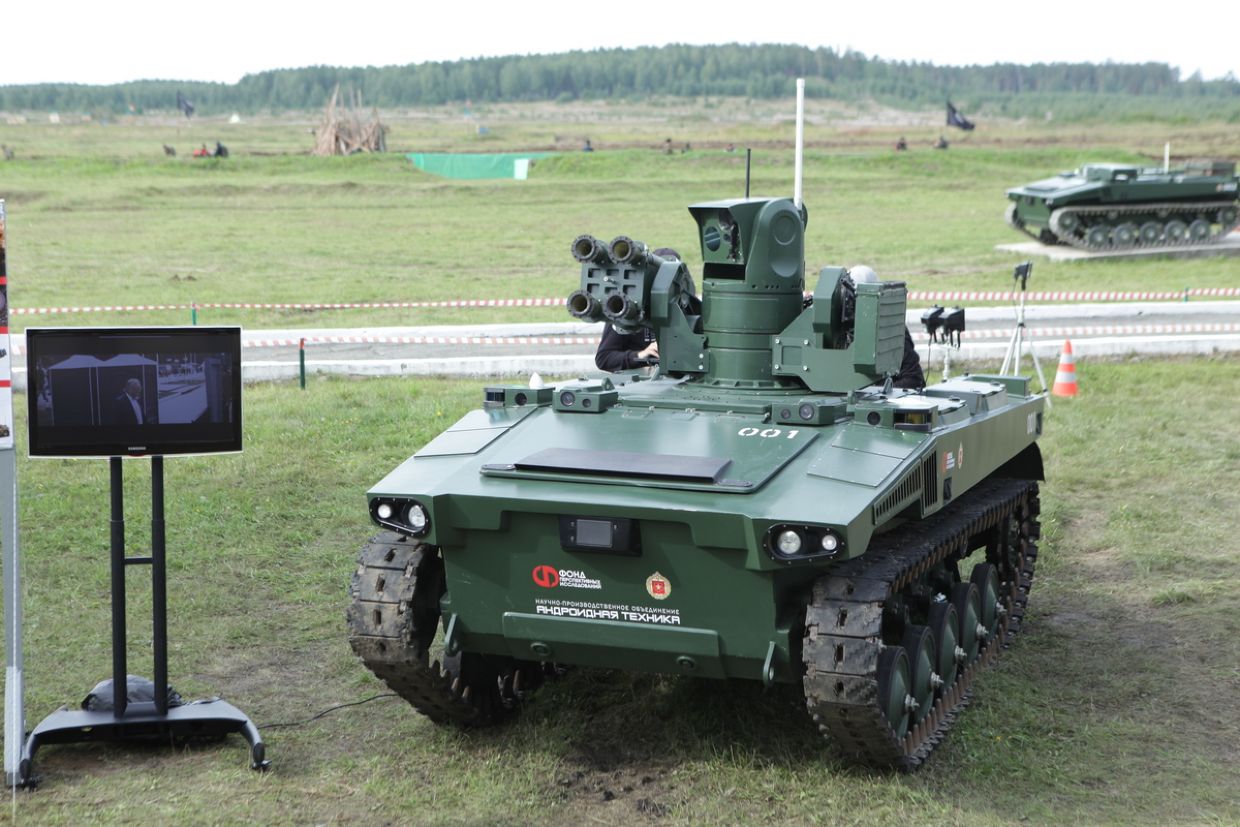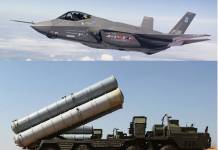Russia’s combat Unmanned Ground Vehicle (UGV) Marker can reportedly operate autonomously for days, and network with other UGVs and Markers, while sharing critical military data.
Marker’s Artificially Intelligence (AI)-enabled system helps identify friendly vehicles and soldiers through camouflage patterns on their combat uniforms and insignia patches.
These staggering capabilities were revealed in a German media report that interacted with the representatives of the private company that developed the UGV, touted as a “Leopard tank killer.”
And while the UGV’s AI-Machine Learning system is being updated with images and information on Western tanks to identify them, Russian soldiers on the frontlines have undertaken exciting battlefield innovation and assembled their ground combat robot.
Videos of this makeshift UGV, armed with a machine gun and a pair of Rocket Propelled Grenades (RPG) externally, went around on various Telegram groups. Appearing to be put together hastily, it still might have significant utility if used well against Ukrainian trenches, infantry, and built-up areas.
The Marker has been promoted especially as a first-of-its-kind tank killer after the US, Britain, and Germany announced sending their M1A2 Abrams (31 units), Challenger-2, and Leopard-2 (14 each) main battle tanks to Ukraine in late January.
Not only are the 59 tanks far from the 300 that Ukraine’s military chief, General Valery Zaluzhny, said would be required to turn the tide against Russia, but they would also take a few months to reach the battlefield by when Russia has been predicted to possibly conclude the war.
Ukrainian tankmen are also likely not to be fully proficient in the Western systems, owing to the complex training procedures and tactics the crews, conditioned to Soviet machinery, operating procedures, and doctrines will take time to transition. The war in Ukraine completed a year this February 24.
Marker Is Even Deadlier!
The report on Anti-Spiegel said the Marker can act independently even if “radio traffic is disrupted” based on instructions by the operators on “waypoints” and “patrol areas” by “independently recognizing and avoiding obstacles.”
This means the Russian developers have considered Western nations employing credible electronic warfare (EW) and jamming to sever the connection between the Marker and its operators.

“The robot can act alone but also in conjunction with other Markers, which can share tasks. For example, one of which takes over reconnaissance and target search, while a second one remains hidden in the background until it attacks the recognized and marked targets,” said the article.
Whether this data linking too is controlled autonomously or has human interference is unknown, but if true, it represents a shockingly giant leap in Artificial Intelligence (AI).
Physical functions like autonomous travel, terrain negotiation, and weapons engagement upon identifying a friend or foe (IFF) are still within the conceivable capability of an autonomous system governed by a highly advanced algorithm. The self-driving over terrain is achieved by a 360-degree field of view, with possibly various cameras and optics distributed around the UGV, not leaving any “blind spot,” according to the German report.
Meanwhile, the IFF is an “electronic catalog” system with images of Western tanks in the regular and infrared format “to identify” the enemy equipment, according to former Roscosmos chief Dmitry Rogozin.
Possibly, an even more advanced version of software used for image referencing and facial recognition technologies must have been developed for the electronic catalog and then fused with the UGV’s fire control system.
But the talking feature described in the report – which implies that two Markers can communicate between themselves and exchange complex and often contextual battlefield data – indicates a giant leap in AI technology and represents a niche capability.
A previous EurAsian Times report had mentioned the Marker having two versions, with one being able to launch small, wire-guided drones that search for targets in “scout” or “reconnaissance” modes. Interestingly, the Marker was not developed for military purposes and was initially meant for rescue tasks in disaster areas.
The drones launched from the UGV have a “wire-guided system” to ensure that data transmission cannot be jammed, besides providing a secure power supply for the drones. It is unclear whether this means a tethered wire from the UGV that spools out to the drone once it takes off. It has “adaptive” and “artificial intelligence,” which the developers are “teaching different types of goals.”
This description suggests a Machine Learning feature where an AI’s autonomous operation progressively becomes error-free through routine corrections by human developers. That these prototype versions are being evolved directly in service is also an interesting weapons development practice that India can use for faster induction of indigenous systems.
Such techno-industrial practices aid rapid scientific development and greater synergy between technologists and the military – a relationship that has been unhealthy and fractured in the Indian scenario.

Russian Soldiers Invent New Makeshift UGV
And what may be considered part of the boom in the Russian drone industry, Russian frontline troops have put together an armed UGV, where a video showed it being tested in the snow. The six-wheeled vehicle lacks an essential feature of a turning turret and has a fixed mount that carries four Rocket Propelled Grenades (RPG) and a PKT machine gun.
In one of the close-up shots, a small camera can be seen on the mount, possibly functioning as its basic optical system. An antenna at the back receives the radio control commands. It lacks advanced features like a Fire Control System (FCS) or a swiveling electro-optical system. The UGV appears to be a fundamental fighting vehicle.
It nevertheless can aid soldiers in massing firepower, even though largely inaccurate, when such tasks can be vulnerable to human physiology and psychology constraints. The UGV’s range and endurance are unknown, and from the video, it can be assumed that it has to remain within line-of-sight of the operator.
The vehicle appears to have decent mobility and is seen firing the PKT and the rockets in a few instances, with at one point being reloaded by a soldier. It can still be of significant tactical help when acting with other ground troops while attacking fixed positions, trenches, or defensive lines.
It is the rapidity with which the Russian forces that developed the UGV can also evolve appropriate tactics and procedures to exploit the system entirely.
- The author can be reached at satamp@gmail.com
- Follow EurAsian Times on Google News




